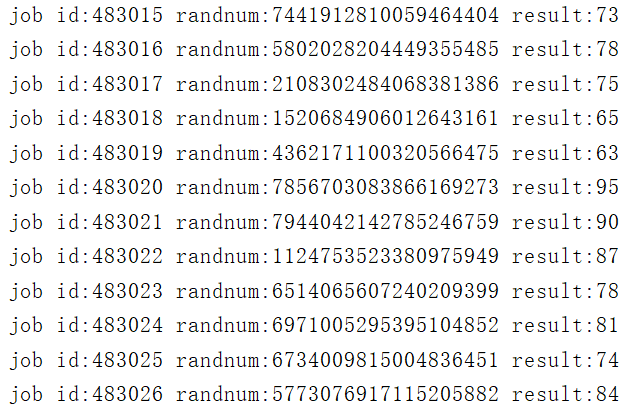Goroutine池
worker pool(goroutine池)
- 本质上是生产者消费者模型
- 可以有效控制goroutine数量,防止暴涨
- 需求:
- 计算一个数字的各个位数之和,例如数字123,结果为1+2+3=6
- 随机生成数字进行计算
- 控制台输出结果如下:

package main
import (
"fmt"
"math/rand"
)
type Job struct {
// id
Id int
// 需要计算的随机数
RandNum int
}
type Result struct {
// 这里必须传对象实例
job *Job
// 求和
sum int
}
func main() {
// 需要2个管道
// 1.job管道
jobChan := make(chan *Job, 128)
// 2.结果管道
resultChan := make(chan *Result, 128)
// 3.创建工作池
createPool(64, jobChan, resultChan)
// 4.开个打印的协程
go func(resultChan chan *Result) {
// 遍历结果管道打印
for result := range resultChan {
fmt.Printf("job id:%v randnum:%v result:%d\n", result.job.Id,
result.job.RandNum, result.sum)
}
}(resultChan)
var id int
// 循环创建job,输入到管道
for {
id++
// 生成随机数
r_num := rand.Int()
job := &Job{
Id: id,
RandNum: r_num,
}
jobChan <- job
}
}
// 创建工作池
// 参数1:开几个协程
func createPool(num int, jobChan chan *Job, resultChan chan *Result) {
// 根据开协程个数,去跑运行
for i := 0; i < num; i++ {
go func(jobChan chan *Job, resultChan chan *Result) {
// 执行运算
// 遍历job管道所有数据,进行相加
for job := range jobChan {
// 随机数接过来
r_num := job.RandNum
// 随机数每一位相加
// 定义返回值
var sum int
for r_num != 0 {
tmp := r_num % 10
sum += tmp
r_num /= 10
}
// 想要的结果是Result
r := &Result{
job: job,
sum: sum,
}
//运算结果扔到管道
resultChan <- r
}
}(jobChan, resultChan)
}
}
定时器
定时器
-
Timer:时间到了,执行只执行1次
-
type Timer
type Timer struct { C <-chan Time // 内含隐藏或非导出字段 }Timer类型代表单次时间事件。当Timer到期时,当时的时间会被发送给C,除非Timer是被AfterFunc函数创建的。
func NewTimer
func NewTimer(d Duration) *Timer
NewTimer创建一个Timer,它会在最少过去时间段d后到期,向其自身的C字段发送当时的时间。
func AfterFunc
func AfterFunc(d Duration, f func()) *Timer
AfterFunc另起一个go程等待时间段d过去,然后调用f。它返回一个Timer,可以通过调用其Stop方法来取消等待和对f的调用。
func (*Timer) Reset
func (t *Timer) Reset(d Duration) bool
Reset使t重新开始计时,(本方法返回后再)等待时间段d过去后到期。如果调用时t还在等待中会返回真;如果t已经到期或者被停止了会返回假。
func (*Timer) Stop
func (t *Timer) Stop() bool
Stop停止Timer的执行。如果停止了t会返回真;如果t已经被停止或者过期了会返回假。Stop不会关闭通道t.C,以避免从该通道的读取不正确的成功。
package main
import (
"fmt"
"time"
)
func main() {
// 1.timer基本使用
//timer1 := time.NewTimer(2 * time.Second)
//t1 := time.Now()
//fmt.Printf("t1:%v\n", t1)
//t2 := <-timer1.C
//fmt.Printf("t2:%v\n", t2)
// 2.验证timer只能响应1次
//timer2 := time.NewTimer(time.Second)
//for {
// <-timer2.C
// fmt.Println("时间到")
//}
// 3.timer实现延时的功能
//(1)
//time.Sleep(time.Second)
//(2)
//timer3 := time.NewTimer(2 * time.Second)
//<-timer3.C
//fmt.Println("2秒到")
//(3)
//<-time.After(2*time.Second)
//fmt.Println("2秒到")
// 4.停止定时器
//timer4 := time.NewTimer(2 * time.Second)
//go func() {
// <-timer4.C
// fmt.Println("定时器执行了")
//}()
//b := timer4.Stop()
//if b {
// fmt.Println("timer4已经关闭")
//}
// 5.重置定时器
timer5 := time.NewTimer(3 * time.Second)
timer5.Reset(1 * time.Second)
fmt.Println(time.Now())
fmt.Println(<-timer5.C)
for {
}
}
-
Ticker:时间到了,多次执行
-
type Ticker
type Ticker struct { C <-chan Time // 周期性传递时间信息的通道 // 内含隐藏或非导出字段 }Ticker保管一个通道,并每隔一段时间向其传递"tick"。
func NewTicker
func NewTicker(d Duration) *Ticker
NewTicker返回一个新的Ticker,该Ticker包含一个通道字段,并会每隔时间段d就向该通道发送当时的时间。它会调整时间间隔或者丢弃tick信息以适应反应慢的接收者。如果d<=0会panic。关闭该Ticker可以释放相关资源。
func (*Ticker) Stop
func (t *Ticker) Stop()
Stop关闭一个Ticker。在关闭后,将不会发送更多的tick信息。Stop不会关闭通道t.C,以避免从该通道的读取不正确的成功。
func Sleep
func Sleep(d Duration)
Sleep阻塞当前go程至少d代表的时间段。d<=0时,Sleep会立刻返回。
Example
func After
func After(d Duration) <-chan Time
After会在另一线程经过时间段d后向返回值发送当时的时间。等价于NewTimer(d).C。
Example
func Tick
func Tick(d Duration) <-chan Time
Tick是NewTicker的封装,只提供对Ticker的通道的访问。如果不需要关闭Ticker,本函数就很方便。
Example
package main
import (
"fmt"
"time"
)
func main() {
// 1.获取ticker对象
ticker := time.NewTicker(1 * time.Second)
i := 0
// 子协程
go func() {
for {
//<-ticker.C
i++
fmt.Println(<-ticker.C)
if i == 5 {
//停止
ticker.Stop()
}
}
}()
for {
}
}
select
select多路复用
在某些场景下我们需要同时从多个通道接收数据。通道在接收数据时,如果没有数据可以接收将会发生阻塞。你也许会写出如下代码使用遍历的方式来实现:
for{
// 尝试从ch1接收值
data, ok := <-ch1
// 尝试从ch2接收值
data, ok := <-ch2
…
}
这种方式虽然可以实现从多个通道接收值的需求,但是运行性能会差很多。为了应对这种场景,Go内置了select关键字,可以同时响应多个通道的操作。
select的使用类似于switch语句,它有一系列case分支和一个默认的分支。每个case会对应一个通道的通信(接收或发送)过程。select会一直等待,直到某个case的通信操作完成时,就会执行case分支对应的语句。具体格式如下:
select {
case <-chan1:
// 如果chan1成功读到数据,则进行该case处理语句
case chan2 <- 1:
// 如果成功向chan2写入数据,则进行该case处理语句
default:
// 如果上面都没有成功,则进入default处理流程
}
- select可以同时监听一个或多个channel,直到其中一个channel ready
package main
import (
"fmt"
"time"
)
func test1(ch chan string) {
time.Sleep(time.Second * 5)
ch <- "test1"
}
func test2(ch chan string) {
time.Sleep(time.Second * 2)
ch <- "test2"
}
func main() {
// 2个管道
output1 := make(chan string)
output2 := make(chan string)
// 跑2个子协程,写数据
go test1(output1)
go test2(output2)
// 用select监控
select {
case s1 := <-output1:
fmt.Println("s1=", s1)
case s2 := <-output2:
fmt.Println("s2=", s2)
}
}
- 如果多个channel同时ready,则随机选择一个执行
package main
import (
"fmt"
)
func main() {
// 创建2个管道
int_chan := make(chan int, 1)
string_chan := make(chan string, 1)
go func() {
//time.Sleep(2 * time.Second)
int_chan <- 1
}()
go func() {
string_chan <- "hello"
}()
select {
case value := <-int_chan:
fmt.Println("int:", value)
case value := <-string_chan:
fmt.Println("string:", value)
}
fmt.Println("main结束")
}
- 可以用于判断管道是否存满
package main
import (
"fmt"
"time"
)
// 判断管道有没有存满
func main() {
// 创建管道
output1 := make(chan string, 10)
// 子协程写数据
go write(output1)
// 取数据
for s := range output1 {
fmt.Println("res:", s)
time.Sleep(time.Second)
}
}
func write(ch chan string) {
for {
select {
// 写数据
case ch <- "hello":
fmt.Println("write hello")
default:
fmt.Println("channel full")
}
time.Sleep(time.Millisecond * 500)
}
}